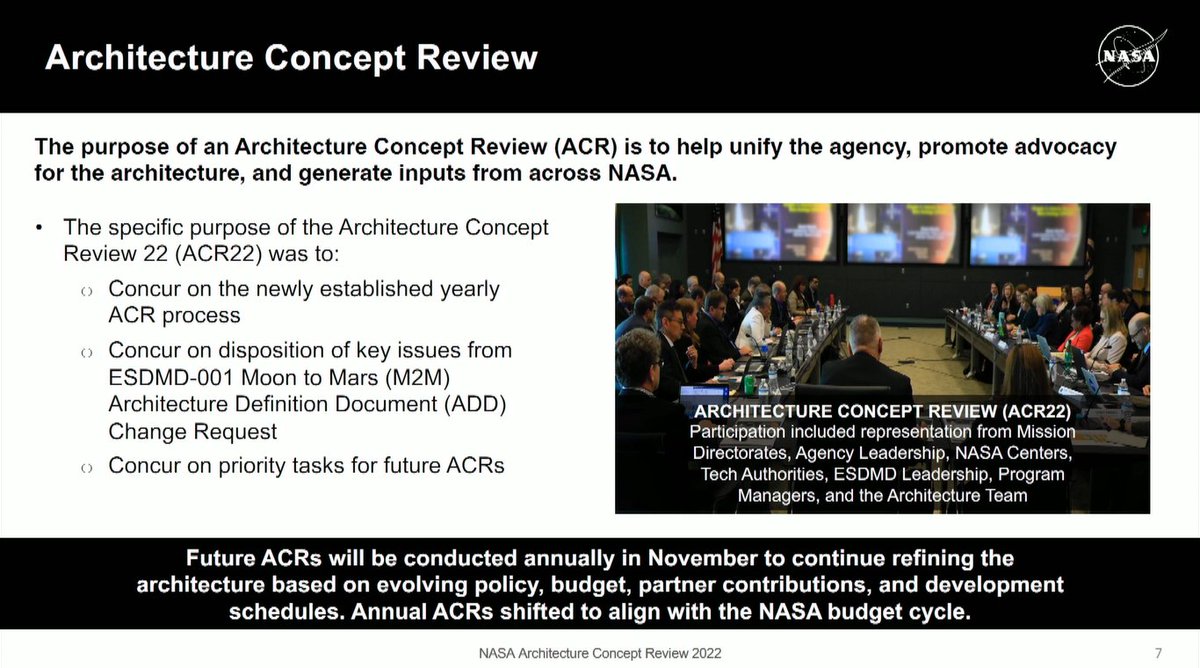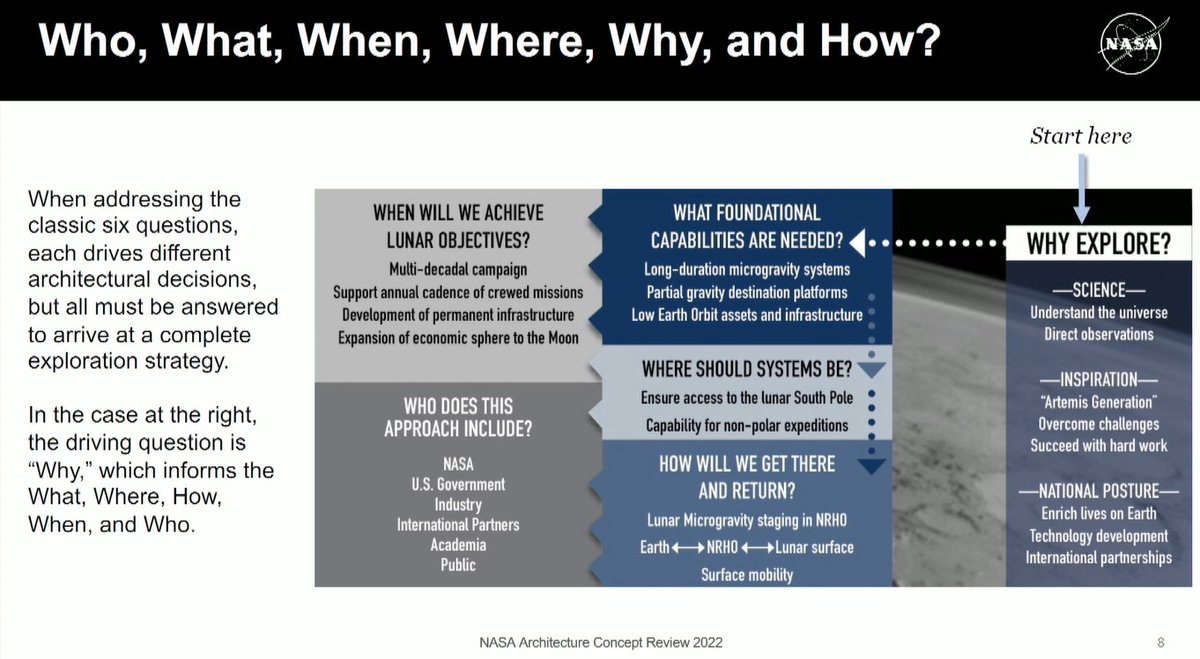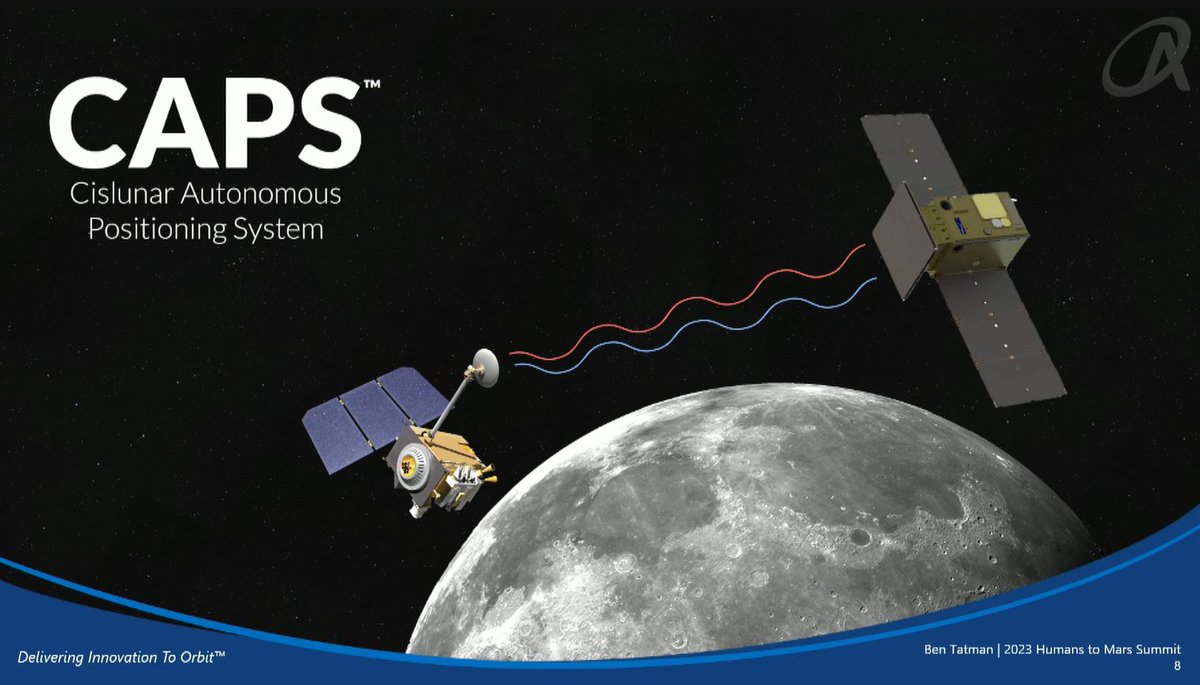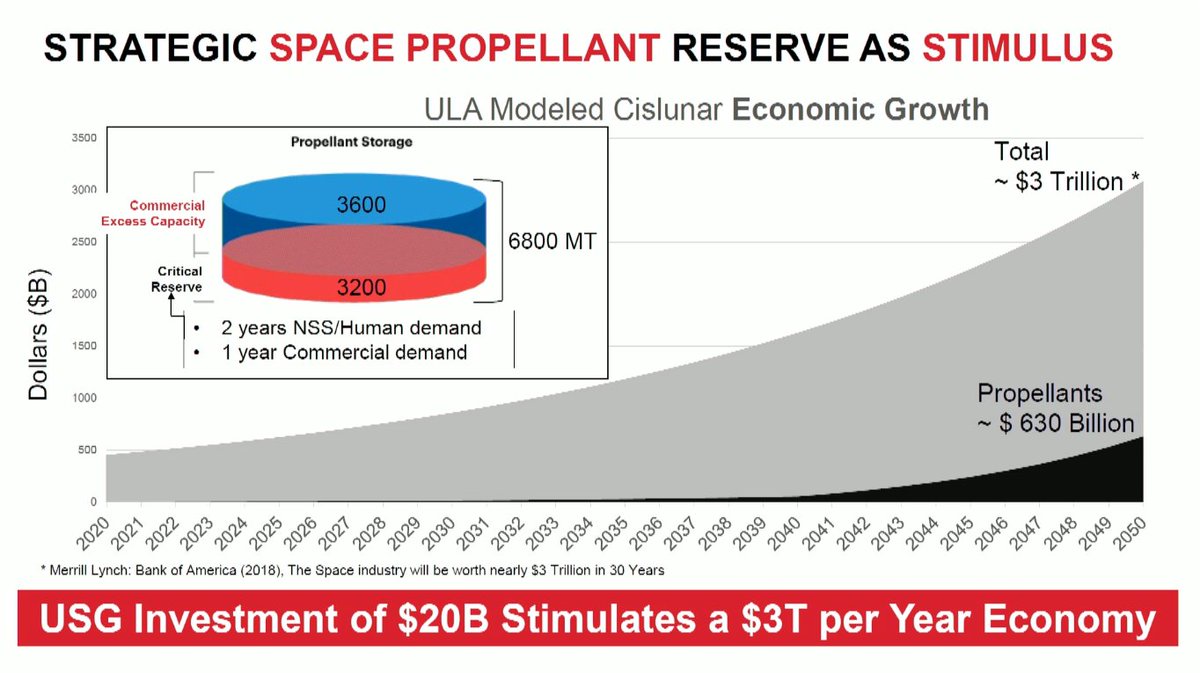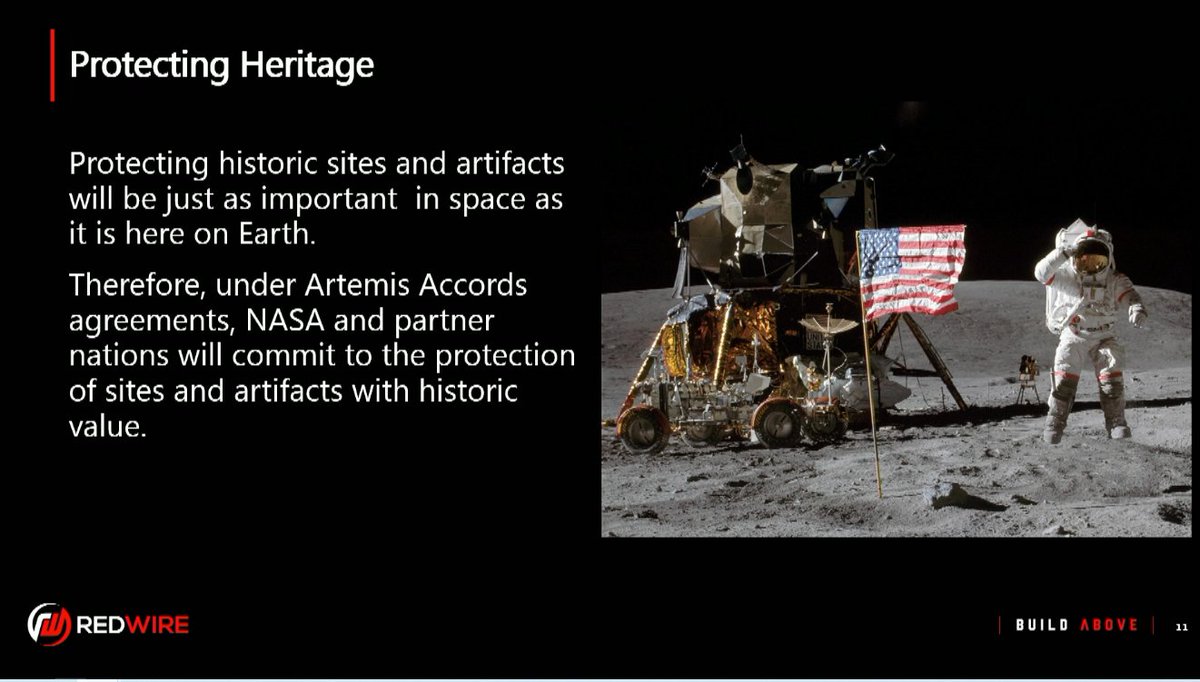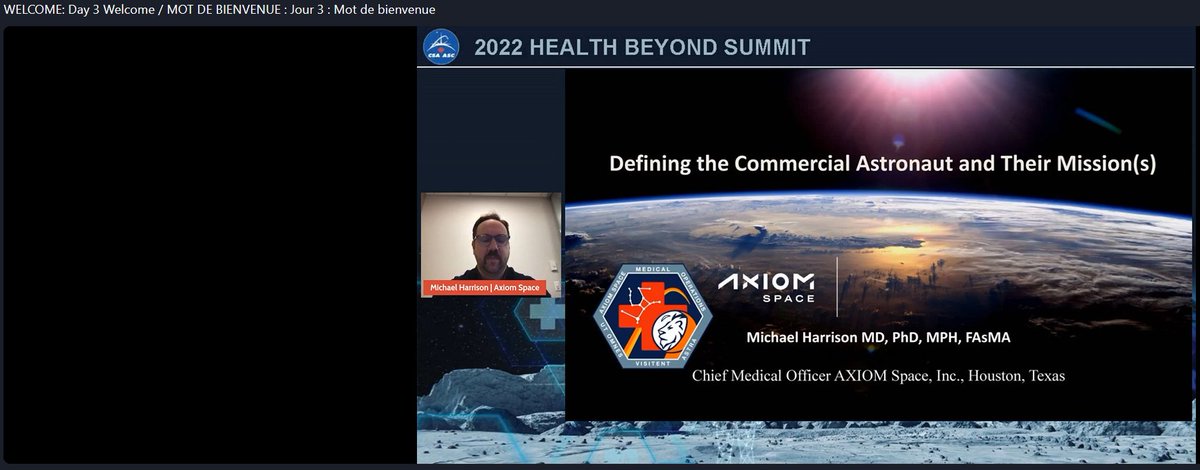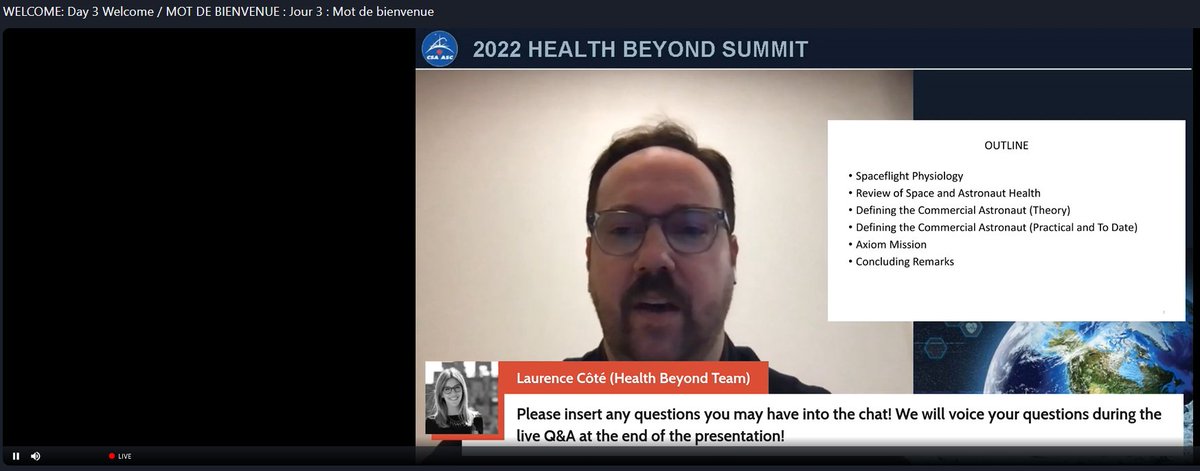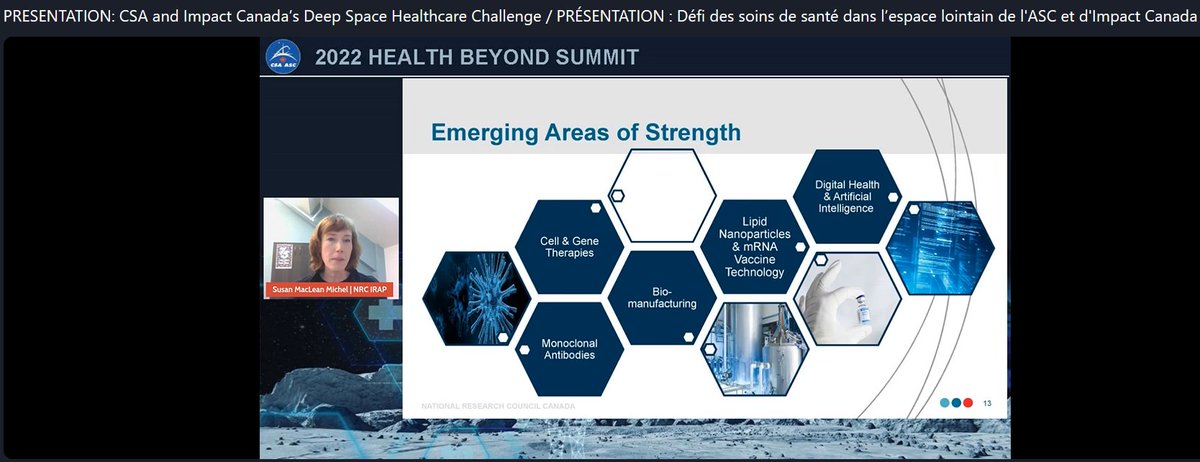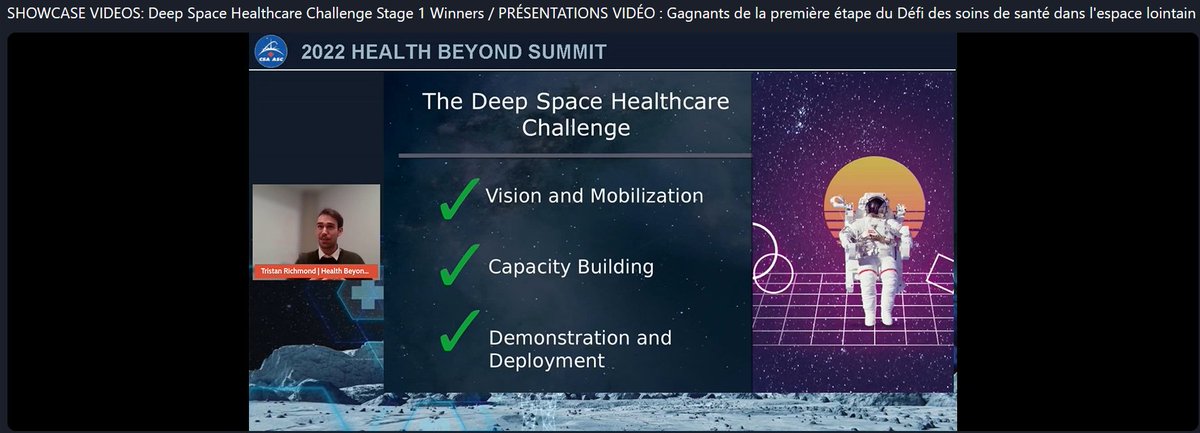Humans to Mars conference by @ExploreMars has kicked off. It's taking place 5/16-18 at the National Academy of Sciences in Washington DC. Free live stream: livestream.com/viewnow/humans…
1/ Humans to Mars Agenda: exploremars.org/summit/#agenda
2/ "Life is not about finding yourself. Life is about creating yourself."
Creating new narrative for humanity, understanding our (new) place in universe.
kickoff with Janet Ivey (Explore Mars, Inc. | President) & Chris Carberry (Explore Mars, Inc. | CEO)
Creating new narrative for humanity, understanding our (new) place in universe.
kickoff with Janet Ivey (Explore Mars, Inc. | President) & Chris Carberry (Explore Mars, Inc. | CEO)

3/ Fireside Chat w/ Robert Cabana, NASA Associate Administrator & former NASA astronaut
Facilitator: Rich Cooper, The Space Foundation, VP, Strategic Comms, Outreach
NASA: non-partisan. It's critical to remain the world leader.
Not a fan of going to Mars on a 1way trip.

Facilitator: Rich Cooper, The Space Foundation, VP, Strategic Comms, Outreach
NASA: non-partisan. It's critical to remain the world leader.
Not a fan of going to Mars on a 1way trip.


4/ 👀 NASA's Moon to Mars strategy: scan QR code or visit go.nasa.gov/3zzSNhp
Critical to know where and why we're going, share that in a way that folks understand it.
Critical to know where and why we're going, share that in a way that folks understand it.

5/ International cooperative efforts. Czechia just joined the Artemis accord.
Starship has 100 seats: Elon will gladly drop off ~4 NASA astronauts on The Moon on the way to Mars 😂
We don't have gateway or lunar lander (yet)
Artemis 3: landing Humans on 🌙: huge challenge!
Starship has 100 seats: Elon will gladly drop off ~4 NASA astronauts on The Moon on the way to Mars 😂
We don't have gateway or lunar lander (yet)
Artemis 3: landing Humans on 🌙: huge challenge!

6/ Soon to announce 2nd 🌙 lander contract to have a redundancy
Looking at all options. Do we have to have a Gateway? All shall deliver *their* hardware on time (regardless of others' timelines), NASA will figure out which missions to fly and when
Looking at all options. Do we have to have a Gateway? All shall deliver *their* hardware on time (regardless of others' timelines), NASA will figure out which missions to fly and when

7/ Reputable notion to a Pittsburgh-based company @astrobotic ((they'll be delivering cargo to the Moon including NASA's; they build rovers and landers and will be also building a solar grid on the Moon))
8/ Q: Who gets to name the spacecraft? How would *you* name it?
A: The crew will name the spacecraft. In conjunction with each other hopefully.
Many great names have been used already. The exact right word has to capture imagination and spirit of what we're doing.
A: The crew will name the spacecraft. In conjunction with each other hopefully.
Many great names have been used already. The exact right word has to capture imagination and spirit of what we're doing.

9/ Advice for young people?
Be really passionate about what you do. Bob loved being a pilot, test pilot, loves being . Study hard, be your best - do something you really enjoys -> easier to do well what you do.
Integrity, teamwork, excellence, inclusion.
Listening vs. hearing

Be really passionate about what you do. Bob loved being a pilot, test pilot, loves being . Study hard, be your best - do something you really enjoys -> easier to do well what you do.
Integrity, teamwork, excellence, inclusion.
Listening vs. hearing


10/ PANEL: Artemis III to Mars: How will Lunar surface missions advance humans to Mars?
Moderator: Beth Mund, Casual Space
Panelist 1: Masaki Fujimoto, JAXA | Deputy Director General of the Institute of Space and Astronautical Sciences
Moderator: Beth Mund, Casual Space
Panelist 1: Masaki Fujimoto, JAXA | Deputy Director General of the Institute of Space and Astronautical Sciences

11/ Panelist 2: Shatel Bhakta (NASA | ESDMD Strategy & Architecture Office, Lunar Architecture Team Lead)
Panelist 3: Ben Tatman (Advanced Space | Senior Astrodynamics and Satellite Navigation Engineer, Section & Project Lead)
Panelist 3: Ben Tatman (Advanced Space | Senior Astrodynamics and Satellite Navigation Engineer, Section & Project Lead)

12/ Panelist 4: Joe Cassady (Aerojet Rocketdyne | Exec. Director, Space)
Panelist 5: Nicholas Cummings (SpaceX | Senior Director, Program Development, Civil and National Security Space)
Panelist 5: Nicholas Cummings (SpaceX | Senior Director, Program Development, Civil and National Security Space)

13/ 1st: send rover to southern Moon region
Then: pressurized rover to the Moon surface
SLIM: Small lander for demonstrations. Can land on slope region - of high interest to science



Then: pressurized rover to the Moon surface
SLIM: Small lander for demonstrations. Can land on slope region - of high interest to science




14/ Tech demo program: to be driven by science teams
Then: Mars exploration
JAXA Mars landing: is a concept
More efficient, more sustainable



Then: Mars exploration
JAXA Mars landing: is a concept
More efficient, more sustainable




16/ Benefits to humanity: science, inspiration, national posture (why Moon and continue to Mars)
Strategy and objectives go.nasa.gov/3zzSNhp
No one given architecture or manifest. Trying to keep it open, allowing for collaboration and integration of assests



Strategy and objectives go.nasa.gov/3zzSNhp
No one given architecture or manifest. Trying to keep it open, allowing for collaboration and integration of assests


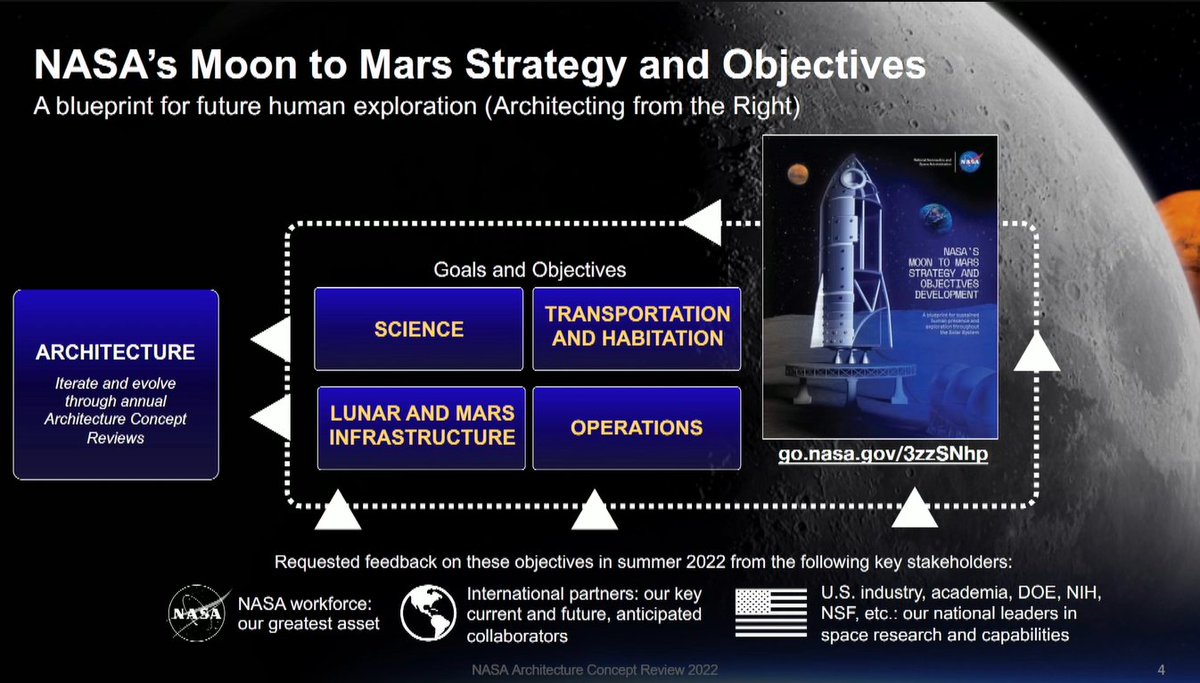

17/ Different directorates within NASA - not just human prospect. It's a synergistic approach. Not as narrow focused as it was in the past. Wider engagement. 

20/ Segments and sub-architectures:
Human lunar return (focus for ACR 22)
Foundational exploration
Sustained lunar evolution
Humans to Mars (focus for ACR 23)
Human lunar return (focus for ACR 22)
Foundational exploration
Sustained lunar evolution
Humans to Mars (focus for ACR 23)

24/ QR code for ADD (Architecture Definition Document, Moon to Mars Architecture Summary & White Papers 
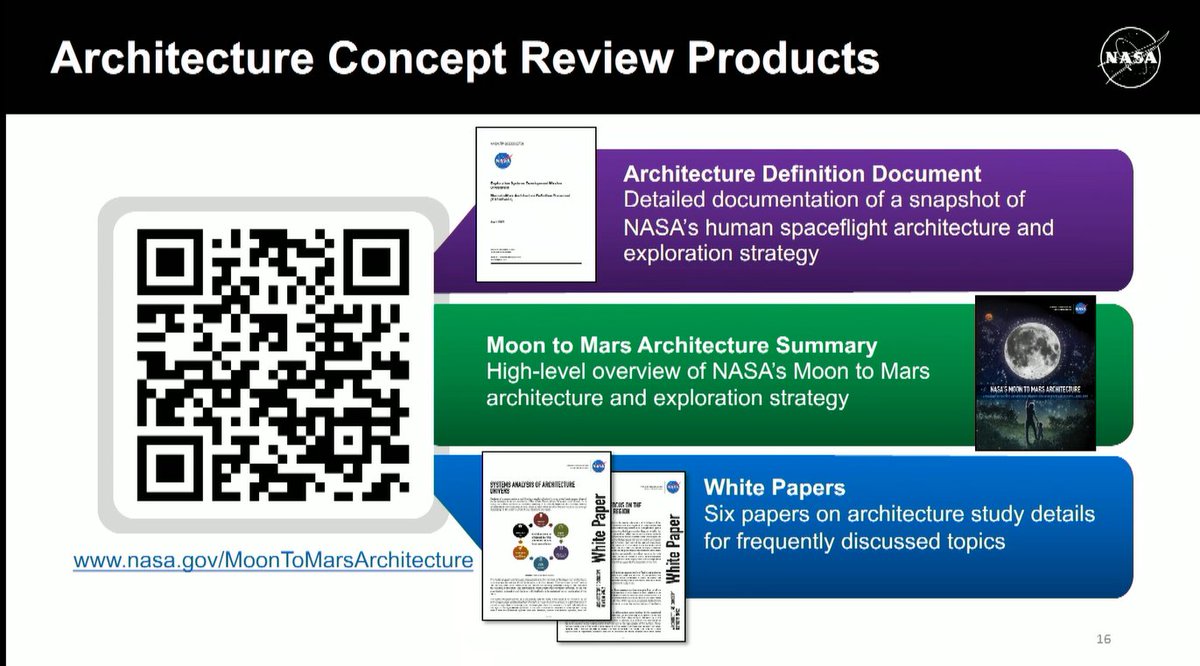
25/ Ben Tatman (Advanced Space | Senior Astrodynamics and Satellite Navigation Engineer, Section & Project Lead) 





27/ Playing a cool video of the NASA's SLS (Space Launch System) on November 16, 2023.
(side note: I was fortunate to see the SLS launch live, it looked like a sunrise, my video:
(side note: I was fortunate to see the SLS launch live, it looked like a sunrise, my video:
https://twitter.com/MartinaTruche/status/1592807922052239360)

32/ SpaceX, Nicholas Cummings
Pressurization done differently on this rocket
A few superheavy boosters & Starships in production
Next test flight shortly
Starship will land people on 🌙 in Artemis 3
Starship capability: take lots of people & tons of cargo to 🌙

Pressurization done differently on this rocket
A few superheavy boosters & Starships in production
Next test flight shortly
Starship will land people on 🌙 in Artemis 3
Starship capability: take lots of people & tons of cargo to 🌙


33/ Q: Some of the things different / more challenging on Mars vs. Moon
- entry, descent, mining
- atmosphere
- terrain
- infrastructure
- challenges are also opportunities
- weight (lightweight missions to the Mars)
- everyone has different pieces, not a full solution
- latency
- entry, descent, mining
- atmosphere
- terrain
- infrastructure
- challenges are also opportunities
- weight (lightweight missions to the Mars)
- everyone has different pieces, not a full solution
- latency

34/ Q: Maars communication challenges wrt architectural ways to communicate. How to run effectively, smoothly? Analog astronauts: challenging to simulate delays.
-free space loss of radio signal: need bigger antena
-solar conjunction on other side of the Sun
-free space loss of radio signal: need bigger antena
-solar conjunction on other side of the Sun

35/ (cont: Mars communication challenges)
-difficulty for reliable comm
- relays
- other architectural elements: satellites on Mars, hub satellite
- higher volume of data
-difficulty for reliable comm
- relays
- other architectural elements: satellites on Mars, hub satellite
- higher volume of data

36/
Gateway (upcoming lunar space station)
- real time communication
- test out systems conceptually
- habitation and transportation modules
- how much can be done by robotic asses?
- Things being done ahead of time
Gateway (upcoming lunar space station)
- real time communication
- test out systems conceptually
- habitation and transportation modules
- how much can be done by robotic asses?
- Things being done ahead of time

37/ Dust is always a problem
- lunar regolith: especially problematic
- Mars: dust in atmosphere - covers solar arrays
-> we need nuclear power
- lunar regolith: especially problematic
- Mars: dust in atmosphere - covers solar arrays
-> we need nuclear power

38/ Q: Challenge of food & medicine: degrade over time. Resupply, logistics, Starship cadence?
- Opportunities: learn to produce food on Mars & in transit
- Experiments on ISS: fresh veggies
- Transport large quantities and store
- Combine w/ local production to keep spirit up
- Opportunities: learn to produce food on Mars & in transit
- Experiments on ISS: fresh veggies
- Transport large quantities and store
- Combine w/ local production to keep spirit up

40/ Q: Artificial gravity?
- numerous studies what it takes to do that
- not a large effort to implement
- not in near term for Moon
- mixed opinions - prospective astronaut: "You wanna put me into space and take away the coolest part - zero G"? 😂
- numerous studies what it takes to do that
- not a large effort to implement
- not in near term for Moon
- mixed opinions - prospective astronaut: "You wanna put me into space and take away the coolest part - zero G"? 😂

41/ Fireside chat w/ @DrSianProctor - 🧑🚀& mission pilot from @inspiration4x
- Earthlight: like Moonlight, just more spectacular
- We'll have Marslight
- Supporting young generations through Proctor Foundation for Art and Science & space camps proctor.foundation

- Earthlight: like Moonlight, just more spectacular
- We'll have Marslight
- Supporting young generations through Proctor Foundation for Art and Science & space camps proctor.foundation


42/ Still in touch with the @inspiration4x crew. Yes - @DrSianProctor would love to go back to space. Is a qualified pilot for Dragon, happy to upgrade to Starship 😇🚀
Analogs (analog astronaut missions): roadmap for Moon and Mars
Analogs (analog astronaut missions): roadmap for Moon and Mars
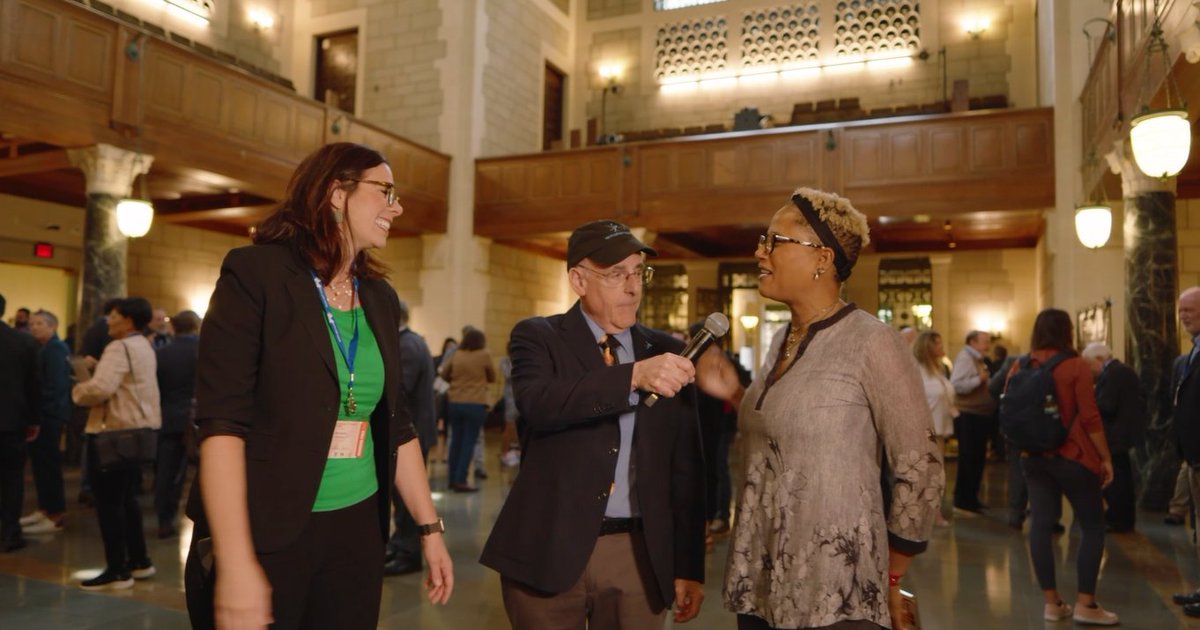
43/ @DrSianProctor
- made a cookbook for analogs
- investigated food strategies for NASA for 4 months
- add a chef title ;)
We don't want astronauts to be hangry!
- made a cookbook for analogs
- investigated food strategies for NASA for 4 months
- add a chef title ;)
We don't want astronauts to be hangry!
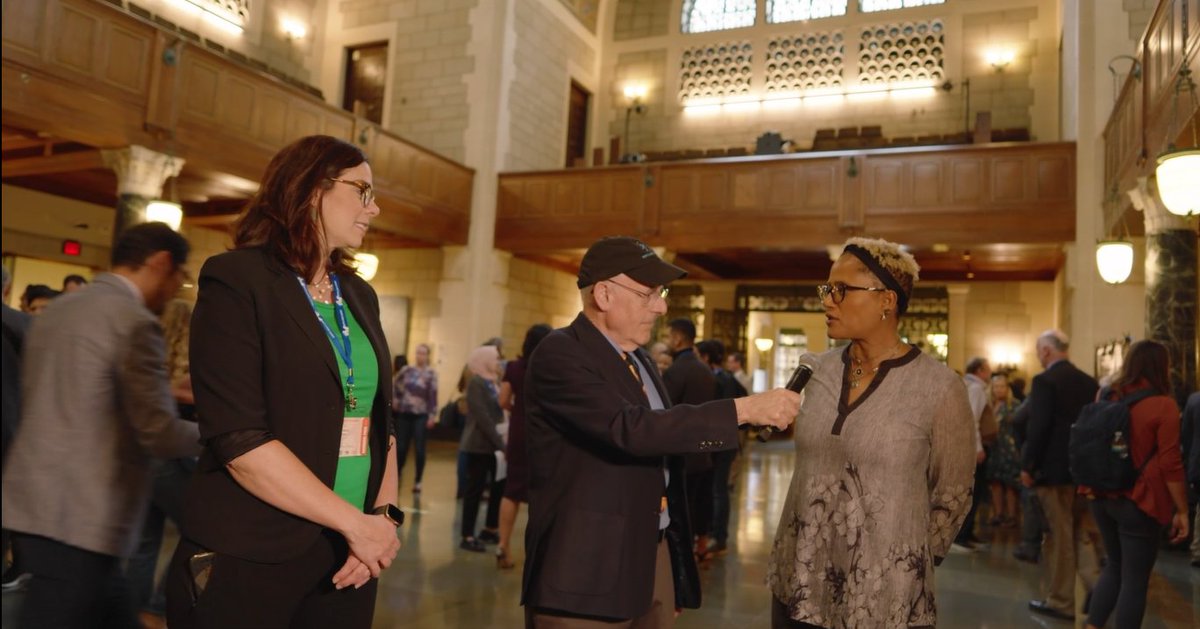
45/ Panel: DRACO Program – Nuclear Propulsion
Moderator: Dr. Bhavya Lal: @NASA | Associate Administrator for Technology, Policy, and Strategy
Dr. Tabitha Dodson: @DARPA | DRACO Program Manager)
Anthony Calomino (@NASA | STMD, Space Nuclear Technology Portfolio Manager

Moderator: Dr. Bhavya Lal: @NASA | Associate Administrator for Technology, Policy, and Strategy
Dr. Tabitha Dodson: @DARPA | DRACO Program Manager)
Anthony Calomino (@NASA | STMD, Space Nuclear Technology Portfolio Manager


46/ NASA has been investing in nuclear tech & propulsion for a while
Nuclear thermal propulsion: relatively new concept.
Reactor as a heat exchanger, extremely high temperature. Have to have a reactor that can operate those temperatures
Nuclear thermal rocket engine
Nuclear thermal propulsion: relatively new concept.
Reactor as a heat exchanger, extremely high temperature. Have to have a reactor that can operate those temperatures
Nuclear thermal rocket engine

47/ Cislunar: opportunity to develop operational capability: transpiration system Earth ->Moon, ascend & descend capability.
Translate to Mars.
Fission surface power
- Capability driven by fission: 10s KW -> MW of
power
- 40KW range
- scale up or down (Mars vs Moon)
Translate to Mars.
Fission surface power
- Capability driven by fission: 10s KW -> MW of
power
- 40KW range
- scale up or down (Mars vs Moon)

48/ Nuclear electric propulsion. Subscale capability - meaningful for cislunar operations, maybe deep space exploration missions -> integrated systems -> design and investment strategy for human transportation systems for Mars.
Working w/ unis & industries
Working w/ unis & industries

49/ DARPA focusing on nuclear thermal rockets
DRACO=Demonstration for Rocket to Agile Cislunar Operations; NASA & DARPA collab
NASA priorities: reliability & safety
Earth based tests
Once engines operated in space - far from Earth and public for 1000 yrs w/o intent to return
DRACO=Demonstration for Rocket to Agile Cislunar Operations; NASA & DARPA collab
NASA priorities: reliability & safety
Earth based tests
Once engines operated in space - far from Earth and public for 1000 yrs w/o intent to return

50/ How Space Debris Could Prevent Mission To Mars
Brian Bartelo - a talented young student ; The Mars Generation


Brian Bartelo - a talented young student ; The Mars Generation



51/ If people break their bike, do they retrieve it? (most do if they can).
Retrieving space debris is harder than on Earth: have to catch it & bring back

Retrieving space debris is harder than on Earth: have to catch it & bring back


53/ Hard to quantify: what's debris vs. dust?
Like measuring leaves in the windstorm
Hard to track: esp. when unable to communicate w/ satellite (e.g. when broken)
Like measuring leaves in the windstorm
Hard to track: esp. when unable to communicate w/ satellite (e.g. when broken)
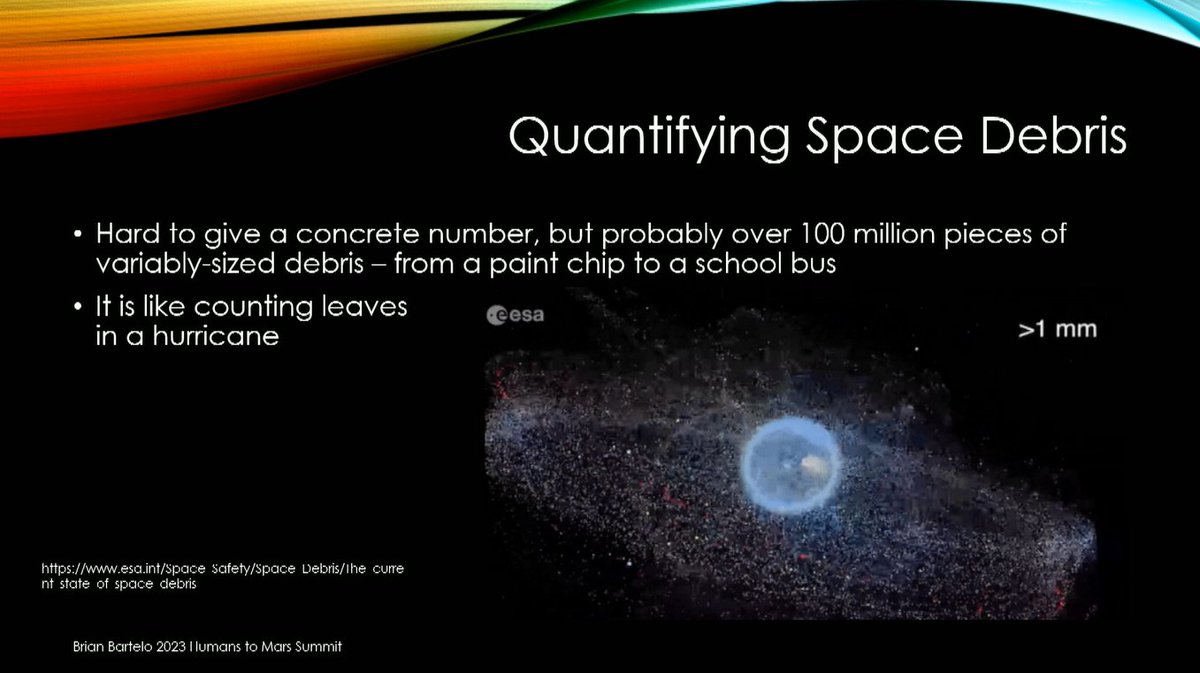
54/ Look for specific objects, specific satellites for more data: astria.tacc.utexas.edu/AstriaGraph 
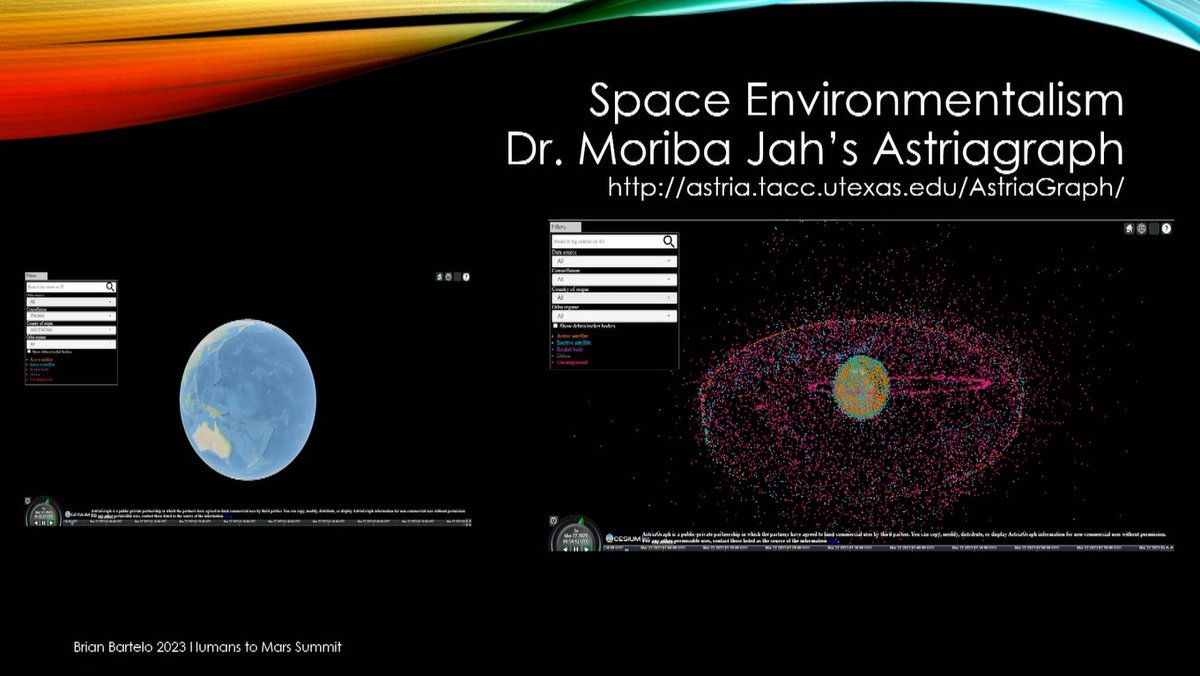
55/ quoting @DrSianProctor : debris is something we need to chase after it
We belong to the stars
referring to @ChrisSembroski: @inspiration4x had a shield to protect form a debris, but were at a higher risk due to higher altitude
Space tourism impacts


We belong to the stars
referring to @ChrisSembroski: @inspiration4x had a shield to protect form a debris, but were at a higher risk due to higher altitude
Space tourism impacts



56/ Talking w/ experts:
Space debris problem is far away from being solved
Spoke w/ Artemis: biz & companies have to be working together, not just one or another - all unique advantages and problems
Space debris problem is far away from being solved
Spoke w/ Artemis: biz & companies have to be working together, not just one or another - all unique advantages and problems
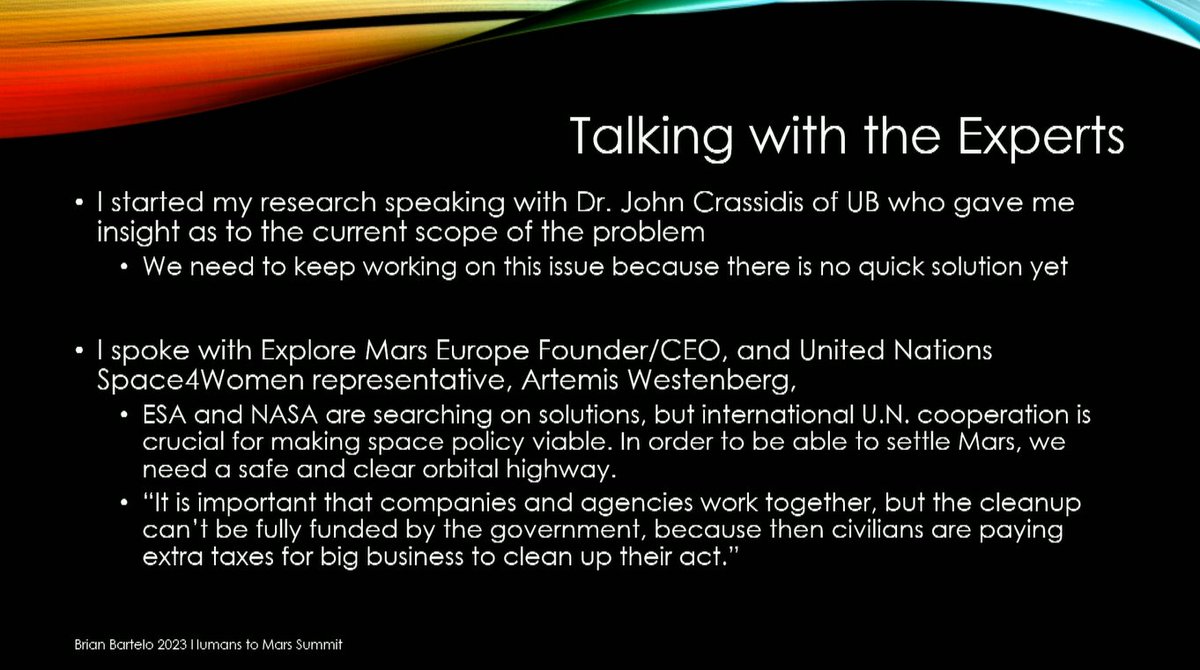
57/ Re space debris:
Has to beneficial to clean up (~reward)
Corporate buy in: best way to solve this
e.g. through contracts from major space agencies
Nobody wants space debris from hitting their house. We have to protect humans on the ground, some materials don't burn out.

Has to beneficial to clean up (~reward)
Corporate buy in: best way to solve this
e.g. through contracts from major space agencies
Nobody wants space debris from hitting their house. We have to protect humans on the ground, some materials don't burn out.


59/ Reward innovation
Develop strtegies to mittigate the issue & take Kessler Syndrome serously
Have an env plan for space
-> to explore Mars



Develop strtegies to mittigate the issue & take Kessler Syndrome serously
Have an env plan for space
-> to explore Mars




60/ Mars Science Precursors & Objectives
Moderator: Jim Green, @NASA Chief Scientist, Ret
Lori Glaze, @NASA Dir Planetary Science
Albert Haldemann, @esa ESTEC, Mars Chief Eng, Mars Exploration Grp
Masaki Fujimoto, @JAXA_en Deputy Dir Gen - Institute of Space & Astro Sciences
Moderator: Jim Green, @NASA Chief Scientist, Ret
Lori Glaze, @NASA Dir Planetary Science
Albert Haldemann, @esa ESTEC, Mars Chief Eng, Mars Exploration Grp
Masaki Fujimoto, @JAXA_en Deputy Dir Gen - Institute of Space & Astro Sciences

62/ Launch form Mars (1st time ever), capture by ESA
Return to Earth in Utah desert
Techniques we haven't developed yet
w/ help of scientists who are probably in elementary school currently


Return to Earth in Utah desert
Techniques we haven't developed yet
w/ help of scientists who are probably in elementary school currently



63/ More frequent smaller missions
Identify potential landing sites
Emphasis on preparing science, taking advantage of int partnerships & commercial capabilities
Emerging interests; how can they explore the solar system
Identify potential landing sites
Emphasis on preparing science, taking advantage of int partnerships & commercial capabilities
Emerging interests; how can they explore the solar system

64/ Inspire
4 elements for exploration endoresed by stakeholders in 2014:
-Knowledge
-Inspiration
-Economy
GLobal Cooperation & Challenges
ESA: MULTInational agency. Partner w/ other agencies aroud the globe.

4 elements for exploration endoresed by stakeholders in 2014:
-Knowledge
-Inspiration
-Economy
GLobal Cooperation & Challenges
ESA: MULTInational agency. Partner w/ other agencies aroud the globe.


65/ Implementation:
1. Humans in LEO (Low Eart Orbit)
2. Humans beyond LEO
3. Moon robotic exploraiton
4. Mars robotic exploraiton
Human physiology
1. Humans in LEO (Low Eart Orbit)
2. Humans beyond LEO
3. Moon robotic exploraiton
4. Mars robotic exploraiton
Human physiology

67/ Masaki Fujimoto (JAXA | Deputy Director General of the Institute of Space and Astronautical Sciences)
MMX: Martian Moons Exploration
JAXA Mars landing in 3 steps



MMX: Martian Moons Exploration
JAXA Mars landing in 3 steps

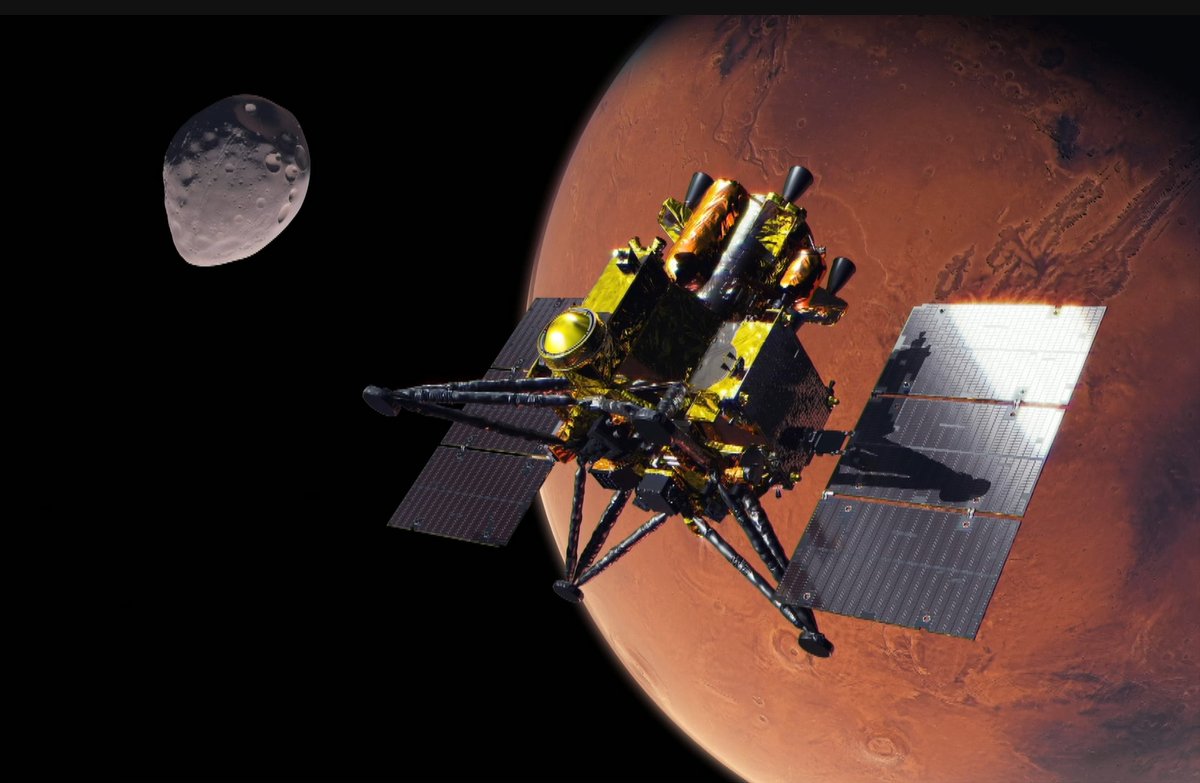


68/ Establishing alternative ways for exploring Mars
Desert of Umera: entry capsule
Martian atmosphere is tenuous, don't have to worry about the heat
Alternative tech for EDL: Inflatable soft air shell
-> Have to worry about descelerating asset to the ground: need bigger area


Desert of Umera: entry capsule
Martian atmosphere is tenuous, don't have to worry about the heat
Alternative tech for EDL: Inflatable soft air shell
-> Have to worry about descelerating asset to the ground: need bigger area



71/ Prevent cross contamination.
Keep samples contained until determined they are safe. How?
Not send humans to Mars, but bring them back
Keep samples contained until determined they are safe. How?
Not send humans to Mars, but bring them back

72/ Institutional challenges
Who are the stakeholders?
Who has the say?
Lot of stakeholders to answer to - takes work
Expecting more surprising in the future: in our understanding. Where are volatiles located on Mars?
Blue sunset, red sky: alien planet!
Who are the stakeholders?
Who has the say?
Lot of stakeholders to answer to - takes work
Expecting more surprising in the future: in our understanding. Where are volatiles located on Mars?
Blue sunset, red sky: alien planet!

73/ Drill: near sub surface
Understand gradient of oxidation
Geotech environment needs to be understood to send humans
Water: critical resource. How deep in the crust?
Understand gradient of oxidation
Geotech environment needs to be understood to send humans
Water: critical resource. How deep in the crust?

74/ What new exciting things will take place that human explorations can take advantage of?
Interesting question - when will we know enough?
Not ready to send humans to Mars until more confident about synergy w/ robotic systems
Interesting question - when will we know enough?
Not ready to send humans to Mars until more confident about synergy w/ robotic systems

75/ Different agencies, different timelines, different budgetary challenges at different times.
Agencies benefit from the collaborations.
Emerging interest in smaller countries w/ smaller budgets. Looking for opportunities to expand community of partners.
Agencies benefit from the collaborations.
Emerging interest in smaller countries w/ smaller budgets. Looking for opportunities to expand community of partners.

76/ Convincing stakeholders to add other people
Somebody has to be the metronome and lead: what's done and when, hold others accountable
Somebody has to be the metronome and lead: what's done and when, hold others accountable

77/ Leveraging and demonstrating: Perseverance, Ingenuity, Moxie, instrument the entry shield, astronaut spacesuit and space shield - how they perform and degrade 
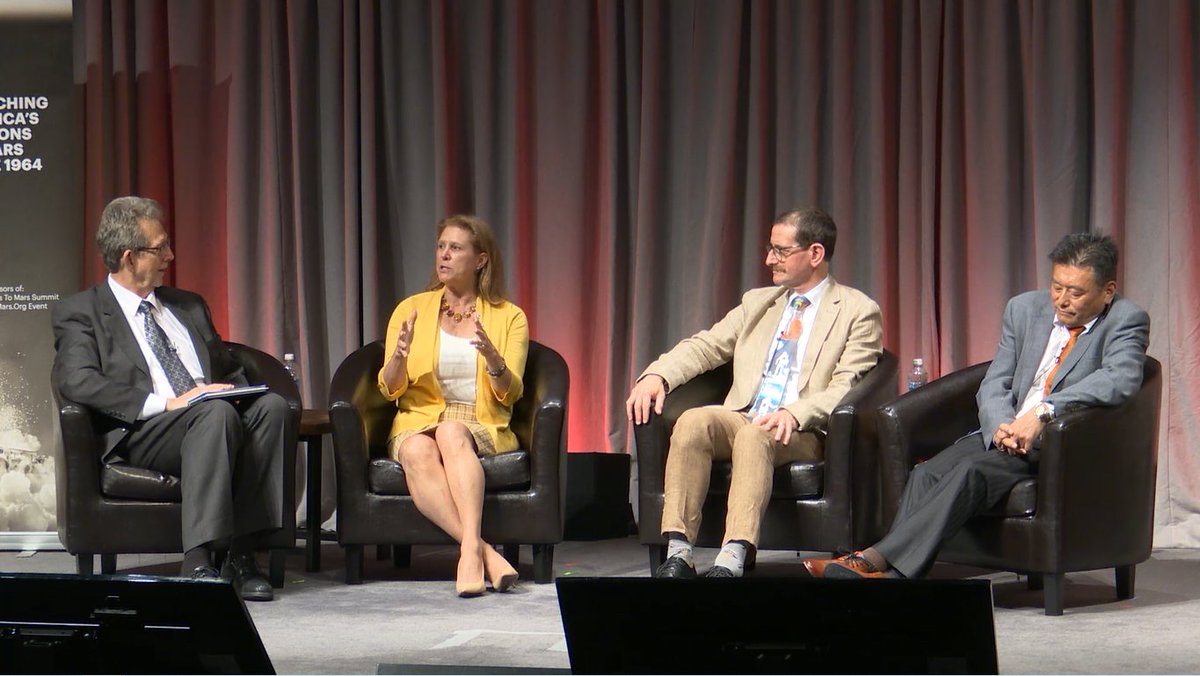
78/ Re Technology:
Portfolio of tech across the board
Knowledge base of what's possible: management, maintenance, communication
Technology is not hardware, it's people and their knowledge how to do something
Become more autonomous - those who operate - fantastic programmers
Portfolio of tech across the board
Knowledge base of what's possible: management, maintenance, communication
Technology is not hardware, it's people and their knowledge how to do something
Become more autonomous - those who operate - fantastic programmers

79/ Reliability vs. capability (e.g. of cube sats - don't have to be standalone, can be embedded in a larger system. Don't have to do everything by yourself w/ a limited capability.) 

80/ Steve Sherman interviewing Lori Glaze during lunch break
DAVINCI a planned mission for an orbiter & atmospheric probe to Venus in 2029; Other Venus missions
@cmu_iris will fly to 🌙
@astrobotic & @Int_Machines sell space on their landers. It's their mission, not NASA's.
DAVINCI a planned mission for an orbiter & atmospheric probe to Venus in 2029; Other Venus missions
@cmu_iris will fly to 🌙
@astrobotic & @Int_Machines sell space on their landers. It's their mission, not NASA's.

81/ Some have tried to get to the Moon. Why is it difficult?
Everything related to space is challenging!
Attempts by multiple parties: Don't expect everyone to land softly ;)
Will we be able to visit the Moon? - Hope so!
Everything related to space is challenging!
Attempts by multiple parties: Don't expect everyone to land softly ;)
Will we be able to visit the Moon? - Hope so!

82/ "Percy" & "Genny" (=Perseverance rover & Ingenuity helicopter lo NASA)
Collecting geologic samples
Q;Chance of finding a microbe, even if fossilized?
- Reasonable probability of past life on Mars
- Present life not likely
Collecting geologic samples
Q;Chance of finding a microbe, even if fossilized?
- Reasonable probability of past life on Mars
- Present life not likely

83/ Jupiter:
- JUICE to explore Jupiter's Moons
- Upcoming mission: Europa Clipper 2024 (leave) -2030-31 (arrive). To map out ice shell, how thick it is, what it's made of, how salty the water is. How deep the ocean is. Europa: one of the most exciting places w/ possible life.
- JUICE to explore Jupiter's Moons
- Upcoming mission: Europa Clipper 2024 (leave) -2030-31 (arrive). To map out ice shell, how thick it is, what it's made of, how salty the water is. How deep the ocean is. Europa: one of the most exciting places w/ possible life.

84/ The Power of Inclusion: Advancing the goal of humans on Mars by empowering underserved communities through analogs and space camps
Introducing:
@macmalkawi (Borderless Labs Inc. | Founder and President)
Salam Abulhaija (Borderless Labs Inc (BLINC) | Science Communicator)


Introducing:
@macmalkawi (Borderless Labs Inc. | Founder and President)
Salam Abulhaija (Borderless Labs Inc (BLINC) | Science Communicator)



85/ Mac: Analog themed space camp
Salam as a litte girl was inspired by a book and movie about a space. Decided to be an astronaut. Saw an ad: spacesuit competition in Jordan - applied and won. 3 challenges of spacesuit design
- chose to solve for Mars.

Salam as a litte girl was inspired by a book and movie about a space. Decided to be an astronaut. Saw an ad: spacesuit competition in Jordan - applied and won. 3 challenges of spacesuit design
- chose to solve for Mars.


86/ Jordan: 2 IIAS scholarships. Tried different astronaut adventures such as a zero G flight or a pressurized spacesuit (Salam's favorite!). 

87/ Other languages don't have exciting space events and documentaries. If we can do that in other languages, we can inspire 100ks young people!
Photo: Salam scuba diving in the red sea.
(This time last yr: was learning how to swim!)
Inspired by @inspiration4x - crew cohesion



Photo: Salam scuba diving in the red sea.
(This time last yr: was learning how to swim!)
Inspired by @inspiration4x - crew cohesion



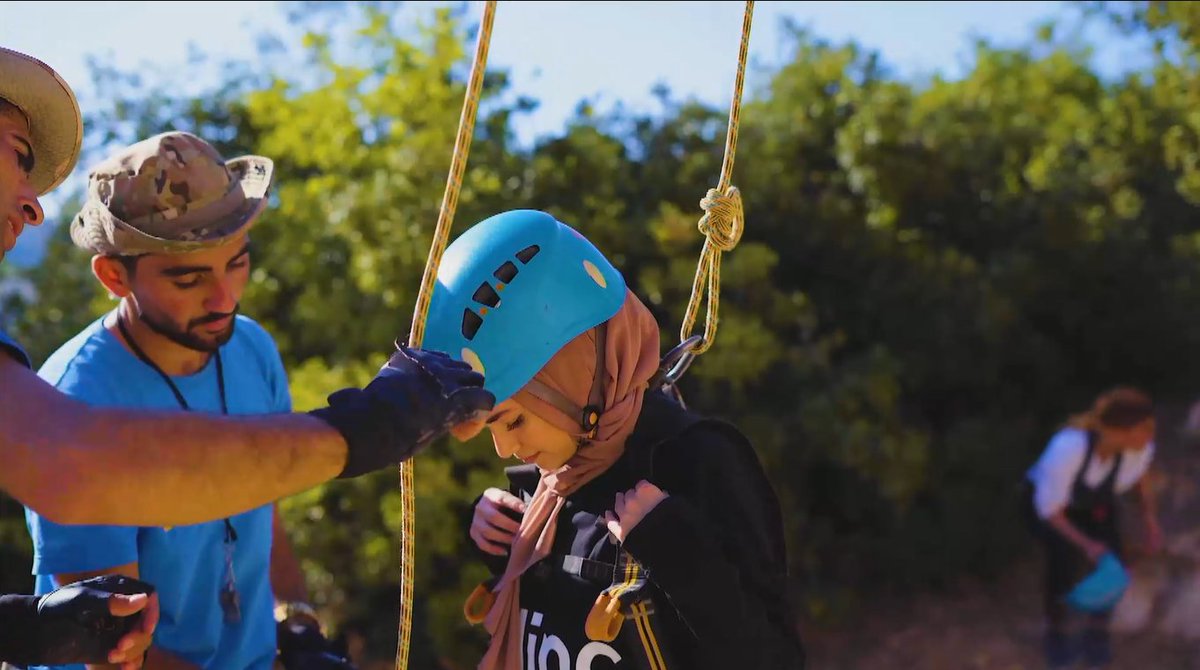
88/ Spacesuit they built is not a costume - it has multiple functional life support systems!
Yupp women can do welding :)
Yupp women can do welding :)

89/ They built a fully functional rover, will be taking to Saudi next wk. Nutrition and other aspects. All to inspire young generations. BLINC: space themed camp. All it took was to give them access. 



90/ Industry Leadership Perspective: The Future of Space
Salvatore T. "Tory" Bruno (ULA | President and Chief Executive Officer)
Starting with a very cool video with animations and demonstration 😍

Salvatore T. "Tory" Bruno (ULA | President and Chief Executive Officer)
Starting with a very cool video with animations and demonstration 😍


91/ History of lunar exploration
We're going back to the Moon
Permanent like ISS: Gateway station on the lunar orbit. Part of architecture is reusable, part is expandable.
Humans will do things boots on the ground that robots can't do
Be safe & practical

We're going back to the Moon
Permanent like ISS: Gateway station on the lunar orbit. Part of architecture is reusable, part is expandable.
Humans will do things boots on the ground that robots can't do
Be safe & practical


93/ "Moon is on the way to Mars": not literally
ifnuclear propulsion, it will be shorter, still a big deal
ifnuclear propulsion, it will be shorter, still a big deal

95/ Radiation continued
Radiation on the space station
Transit out to Mars. If not protected or mistake in protection: get cancer
Mars misison: 1 yr transit, 1 yr on Mars
Robots and humans will be collaborating (it's not either or)


Radiation on the space station
Transit out to Mars. If not protected or mistake in protection: get cancer
Mars misison: 1 yr transit, 1 yr on Mars
Robots and humans will be collaborating (it's not either or)



97/ Space radiation
Radiation shielding:
- Alpha: can't penetrate yr skin. Paper will stop it. Have to eat it to harm you.
- Beta: Aluminum stops it
- Gamma: further down
- Neutrons: the only kind of radiation that makes other things radioactive
- GCS (galactic cosmic rays)

Radiation shielding:
- Alpha: can't penetrate yr skin. Paper will stop it. Have to eat it to harm you.
- Beta: Aluminum stops it
- Gamma: further down
- Neutrons: the only kind of radiation that makes other things radioactive
- GCS (galactic cosmic rays)


98/ Good reasons to stay - not "beat another country" 😉
More global human dignity
Make it affordable and sustainable
Stamina to meet goals, put people permanently on Mars
More global human dignity
Make it affordable and sustainable
Stamina to meet goals, put people permanently on Mars

99/ Cislunar resources:
How can we have a smaller footprint?
People will live and work in space
-> Resources to go to Mars & stay there
How can we have a smaller footprint?
People will live and work in space
-> Resources to go to Mars & stay there

100/ water is everywhere. Not sure in which form -> not sure how to extract it.
Q: what if we run out of water on the Moon? Now: 100M yrs there -> maybe 1M yrs.
Every place we look there is water: Mars
Q: what if we run out of water on the Moon? Now: 100M yrs there -> maybe 1M yrs.
Every place we look there is water: Mars

101 / Materials and manufacturing.
Inexpensive energy. Renewable to balance the grid.
Generate power in space -> Earth -> ubiquitous cheap power everywhere . Not a choke on econ prosperity like today.

Inexpensive energy. Renewable to balance the grid.
Generate power in space -> Earth -> ubiquitous cheap power everywhere . Not a choke on econ prosperity like today.

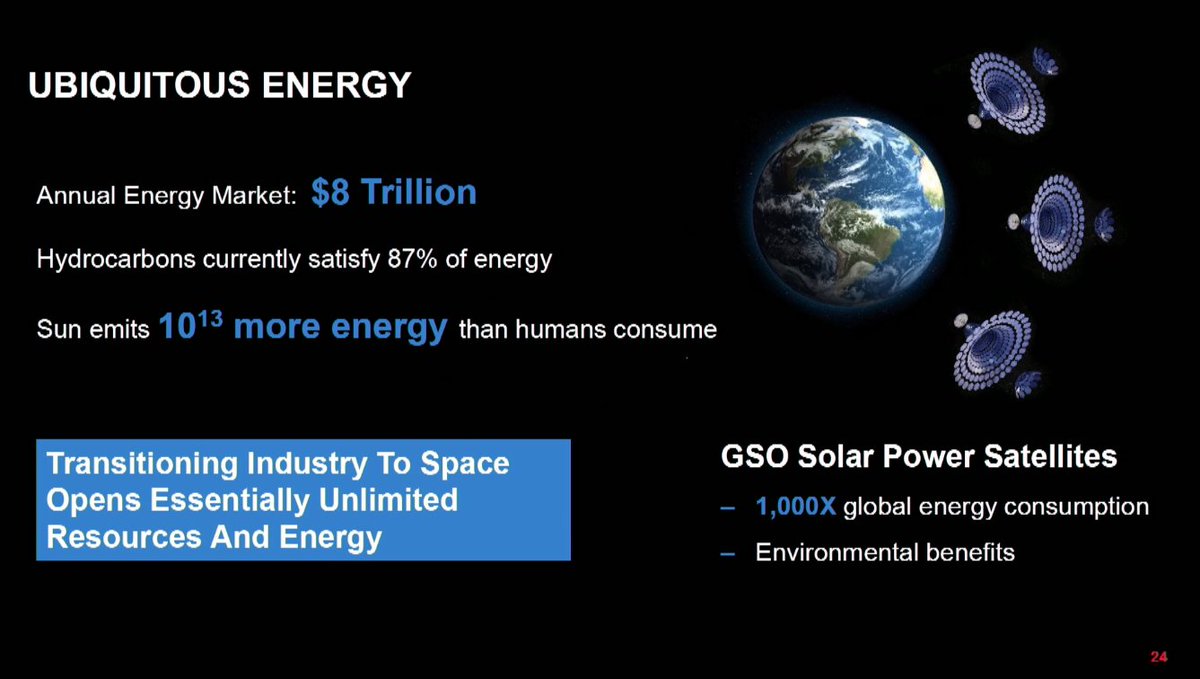
103/ Cislunar timeline 👀🌙
Vision for Moon to Mars
Tourism, exploring -> 100s people living & working in space in the next few decadese
Vision for Moon to Mars
Tourism, exploring -> 100s people living & working in space in the next few decadese
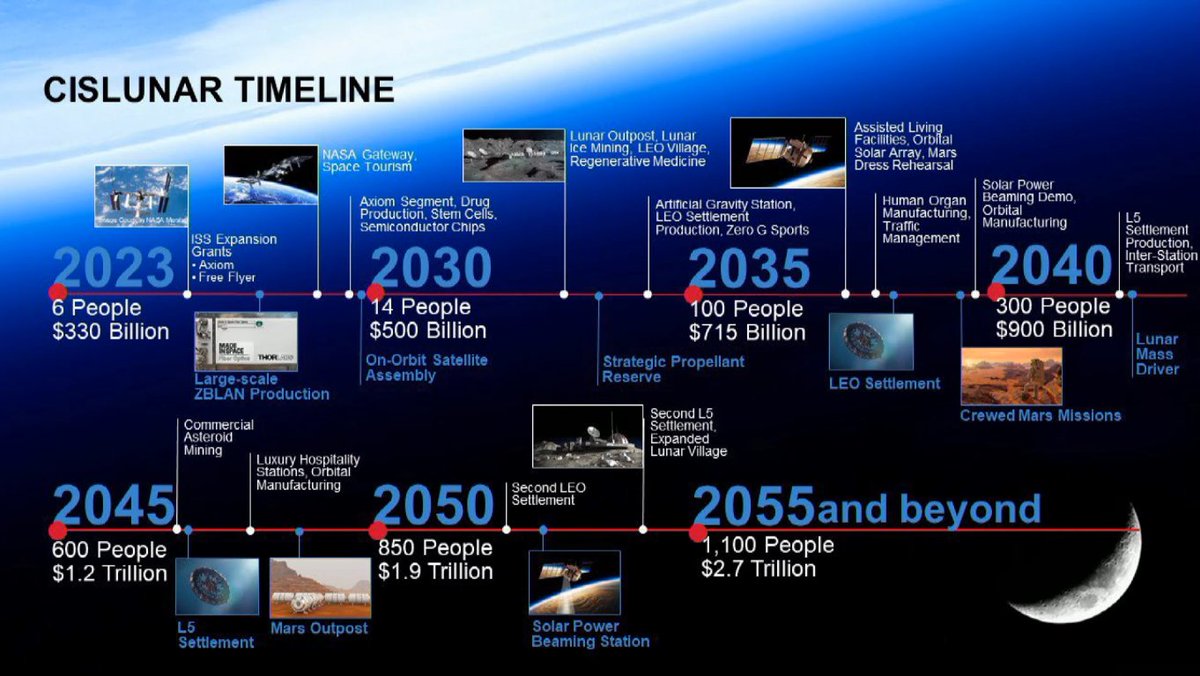
91/ a
105/ International panel on Artemis Accords: An International Campaign to the Moon and Mars
Moderator: Mike Gold - @RedwireSpace
Valda Vikmanis-Keller U.S. State Department
Gabriel Swiney - @NASA
Masami Onoda - @JAXA_en
Aniello Violetti - Embassy of Italy
Moderator: Mike Gold - @RedwireSpace
Valda Vikmanis-Keller U.S. State Department
Gabriel Swiney - @NASA
Masami Onoda - @JAXA_en
Aniello Violetti - Embassy of Italy
106/ Artemis accord and Artemis program
Putting the 1st woman & 1st POC on the Moon
Diversity of nations
Peaceful
Transparency



Putting the 1st woman & 1st POC on the Moon
Diversity of nations
Peaceful
Transparency




109/ Applause for the Czech Republic joining Artemis recently 👏🇨🇿🚀🌙
🇨🇿 24th signatory of Artemis accords
Signed first 2 African nations: Rwanda and Nigeria
Increasing # signatories
Designing missions around these principles


🇨🇿 24th signatory of Artemis accords
Signed first 2 African nations: Rwanda and Nigeria
Increasing # signatories
Designing missions around these principles



110/ How many people here in the room have read the Artemis accords? (seem more should have ;))
You can catch up on #Artemis Accords here: nasa.gov/specials/artem…
You can catch up on #Artemis Accords here: nasa.gov/specials/artem…
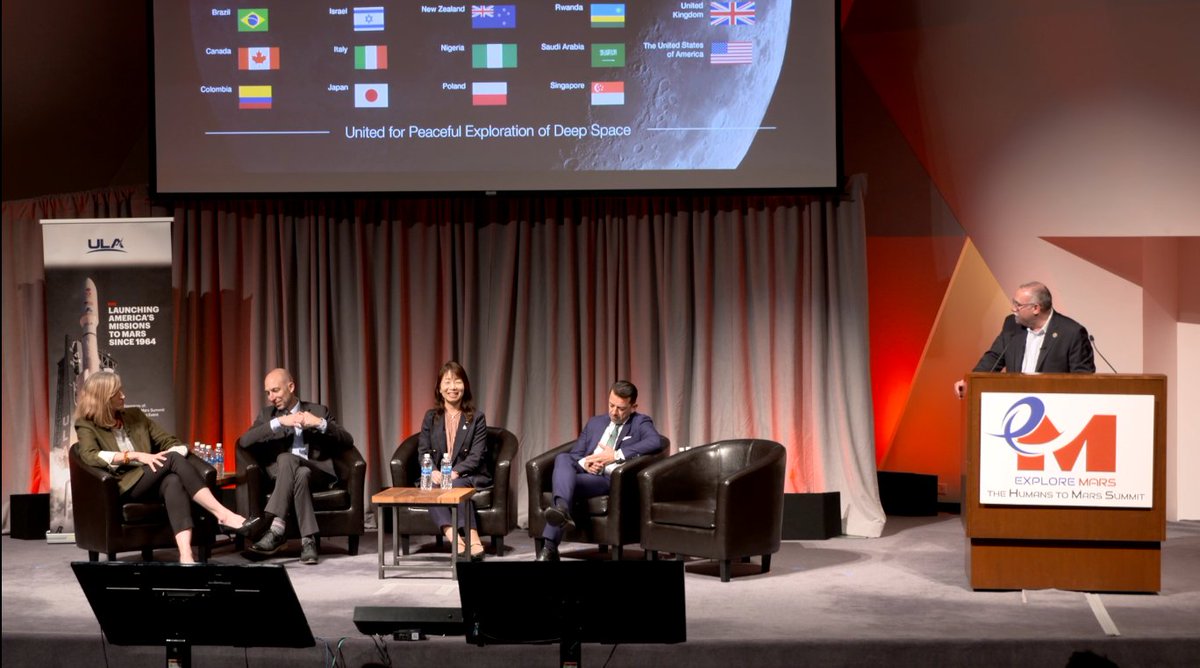
111/ @JAXA_en statement: Joint Exploration Declaration of Intent (JEDI)
Japan would like to land a Japanese astronaut on the Moon by late 2020s
Japan would like to land a Japanese astronaut on the Moon by late 2020s

113/ Are space resources gonna be a thing? People sometimes don't now how to feel about that. Legalities. International churns.
Since Artemis Accord came out in 2020: international and domestic conversations: how we should do space resources
Operational world

Since Artemis Accord came out in 2020: international and domestic conversations: how we should do space resources
Operational world


114/ Questions and discussions include: When does it make sense to use space resources vs. bring stuff with you? 

115/ Mars: Atmosphere, wind, more gravity - more challenging to land & do things. Safety - different. 





116/ Inspiring talk by Charity Weeden, @astroscale_HQ VP of Global Space Policy & Gov Relations
ISAM revolution: in-space servicing, assembly, and manufacturing
Need adoption. Limit risk in orbit. Tap into resiliency reserves when needed. Positive legacy for future gens.
ISAM revolution: in-space servicing, assembly, and manufacturing
Need adoption. Limit risk in orbit. Tap into resiliency reserves when needed. Positive legacy for future gens.

117/ Panel NASA Objectives: What Next? Fireside chat
Moderator: @jeff_foust - @SpaceNews_Inc
Dr. Bhavya Lal (NASA | Associate Administrator for Technology, Policy, and Strategy)
Dr. Kurt (Spuds) Vogel (NASA | Director of Space Architectures, Office of the Administrator)

Moderator: @jeff_foust - @SpaceNews_Inc
Dr. Bhavya Lal (NASA | Associate Administrator for Technology, Policy, and Strategy)
Dr. Kurt (Spuds) Vogel (NASA | Director of Space Architectures, Office of the Administrator)


118/ Understand WHAT we wanna accomplish
Ensure it's:
Achievable
Detailed
Doesn't change
Need sufficient funding to get the job done
Ensure it's:
Achievable
Detailed
Doesn't change
Need sufficient funding to get the job done

119/ WHAT are we trying to accomplish?
Some accomplished on Moon or Mars. It's neither. We're developing blueprint for sustained human presence in solar system
Some accomplished on Moon or Mars. It's neither. We're developing blueprint for sustained human presence in solar system

120/ Start w/ the goal. Decompose. What does it take to do that?
→ Inject tech solutions
→ Mosaic who's doing what
Consistency & resiliency (to budget, tech solutions, politically) Same answers & goals.
Honor 4th principle: be unified
Communication & feedback
→ Inject tech solutions
→ Mosaic who's doing what
Consistency & resiliency (to budget, tech solutions, politically) Same answers & goals.
Honor 4th principle: be unified
Communication & feedback

121/ Scope:
- Get to Moon?
- Do the minimum?
- Go to Mars w/o Moon?
Get there → survive → thrive → be productive
Analog activities for Mars - blueprint demo
- Get to Moon?
- Do the minimum?
- Go to Mars w/o Moon?
Get there → survive → thrive → be productive
Analog activities for Mars - blueprint demo

122/ Top-level goals
Strategic principles
Architecture concept reviews (see QR code to see docs)
Not realistic to have all architecture after a few months
Exploration, global utilization, lunar evolution, mars analog



Strategic principles
Architecture concept reviews (see QR code to see docs)
Not realistic to have all architecture after a few months
Exploration, global utilization, lunar evolution, mars analog




123/ Bhavya Lal @NASA: What will these operations mean for NASA & humanity? Future aligned w/ values.
Overarching considerations
Protect special locations on Moon & Mars w/ unique characteristics: Eternal light: crucial for solar power. Quiet zone. Limited area w/ lots interest.


Overarching considerations
Protect special locations on Moon & Mars w/ unique characteristics: Eternal light: crucial for solar power. Quiet zone. Limited area w/ lots interest.



124/ Not all materialize as NASA missions: some by industry under NASA contract
❓How do data transparency policies apply to purchased vs. collected data?
❓How not to bring harmful contamination?
(tech vs. 🧑🚀)
❓Impact on biosphere
❓Ethics (NASA recently held a workshop)
❓How do data transparency policies apply to purchased vs. collected data?
❓How not to bring harmful contamination?
(tech vs. 🧑🚀)
❓Impact on biosphere
❓Ethics (NASA recently held a workshop)

125/ M2M Objectives and Categories
Physics & physical science
How should NASA partner w/ international partners?
Physics & physical science
How should NASA partner w/ international partners?

129/ Tech people have to put the bets down: which tech are we gonna need?
Evolutionary architecture process: We'll be hitting Mars again and again and refine:
Analog activities. Moon and Mars are difference. Regolith and processes different, but lessons learned.
Evolutionary architecture process: We'll be hitting Mars again and again and refine:
Analog activities. Moon and Mars are difference. Regolith and processes different, but lessons learned.

130/ Need a steady cadence. Listen, transmit, explain what's going on.
Webinar next wk & workshop in June (details to be announced)
Can imagine yearly cadence.
Webinar next wk & workshop in June (details to be announced)
Can imagine yearly cadence.

131/ Q: Where are we gonna go after Mars?
Dr. Kurt (Spuds) Vogel: Picture: Europa. That's not NASA saying we're gonna go there. It's a blueprint.
Dr. Bhavya Lal: depends robots vs. humans

Dr. Kurt (Spuds) Vogel: Picture: Europa. That's not NASA saying we're gonna go there. It's a blueprint.
Dr. Bhavya Lal: depends robots vs. humans


132/ Can imagine a balance of traditional vs. new approach
Objectives & goals established separate from specific tech solutions or acquisition approaches
Commercial crew & cargo very successful. Leverage experiences to change paradigm.
Caution: careful how we press forward.
Objectives & goals established separate from specific tech solutions or acquisition approaches
Commercial crew & cargo very successful. Leverage experiences to change paradigm.
Caution: careful how we press forward.

133/ Concluding day 1 of H2M 2023
On of the main highlights: being there w/ Mars community who will put us on the red planet
"What happens if the toilet breaks on the way to Mars? - Everybody dies!"
Important topics: analogs and accessibility

On of the main highlights: being there w/ Mars community who will put us on the red planet
"What happens if the toilet breaks on the way to Mars? - Everybody dies!"
Important topics: analogs and accessibility


134/ @threadreaderapp unroll
• • •
Missing some Tweet in this thread? You can try to
force a refresh

 Read on Twitter
Read on Twitter


